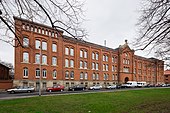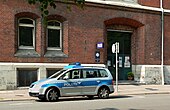Welfenplatz (Hanover)
The Welfenplatz in Hannover is about 6 hectare large parking area in the district List near the pedestrian Lister mile . The square was built in the middle of the 19th century as a military area at the gates of the garrison town of Hanover.
Surname
The Welfenplatz is named after the family of the Welfen who ruled the Kingdom of Hanover when the square was built around 1860 . Just a few years later, after their defeat in the Battle of Langensalza , they were dethroned by the Prussians in 1866 .
Cityscape
The 200 × 300 m large Welfenplatz is today a green oasis between Celler Strasse and Strasse Am Welfenplatz . On the side facing Celler Straße , it is on a busy arterial road that leads north-east out of the city center. With lawns, a football field, table tennis tables, trees, seating areas, a children's playground and a roller-skating and skate track, the place invites you to play and linger. It is built on with a school, a kindergarten, a gas station, the graffiti- decorated bunker on Welfenplatz from World War II and the container village for street children built by Han Slawik with the "bed by night" project supported by Nicolas Kiefer . The square only got its current appearance after 1945, after its military use ended. The Apostle Church is located on Welfenplatz .
On the upper floor of the bunker is located since 2012, the Bat Center Hannover , which by the AG bats of the BUND is operated voluntarily. There, injured or sick bats are nursed to health and released back into the wild as part of bat protection initiatives .
A limestone obelisk on the east side of Welfenplatz commemorates the fallen soldiers who were once stationed in the barracks. They belonged to the Scharnhorst Field Artillery Regiment (1st Hannoversches) No. 10, the 6th Artillery Regiment of the Reichswehr and the 19th Artillery Regiment of the Wehrmacht .
The B-tunnel of the light rail runs under the square, and an emergency exit leads to the square. Since the distance to the nearest underground stations Hauptbahnhof and Werderstraße is relatively large, the Hanover region is planning to build a Welfenplatz underground station . The realization of these plans is uncertain.
Welfenplatz as a green oasis: on the far left former barracks (today a police building), in front of it a school building, in the foreground the Lower Saxony State Criminal Police Office
Container village for street children next to the bunker
Military history
The Welfenplatz was created in the 19th century in the open field at the gates of Hanover as a parade ground . A similarly military-related method of development is the case in Hanover at Waterlooplatz and Königsworther Platz . Around 1850 the Hanoverian War Ministry bought a large area of pasture from farmers in the village of List on sandy, barren soil. In 1857 the construction of three barracks began on the north side of the 200 × 300 m square for soldiers of the Kingdom of Hanover . In 1867 the Prussian state, which had taken over the Kingdom of Hanover a year earlier, had two more barracks built on the east side of the square. All barracks were built in red brick on a light sandstone base .

At the end of the 19th century, the area around Welfenplatz was a military quarter (see picture on the left). Its barracks for infantry and mounted artillery units housed:
- 2,000 soldiers
- 500 horses
- 50 field guns
The barracks buildings were enormous at the time, each with a street frontage of 100 m and a building height of up to 30 m. For the soldiers, the inside was crowded, as up to 28 men were accommodated in a 40 m² room. There was more space available for the horses in the spacious stables.
During the Second World War , the bunker on Welfenplatz was built on Welfenplatz as a raised bunker against enemy air attacks. Its sloping, tiled roof was just a dummy to make attacking bombers look like a residential building.
During the British and American air raids on March 25 and 28, 1945 with 600 bombers each , the eastern districts of Hanover were badly hit. Three of the five barracks on Welfenplatz were so badly damaged that only demolition was an option.
Soldiers of the 1st Hanoverian Infantry Regiment No. 74 drill on the square around 1898
Field guns in front of Artillery Barracks XI on the east side of the square
The 74th Infantry Regiment marched out on mobilization day on August 2, 1914 by "the crowd on Welfenplatz [...]"
Listed war memorial in front of a remaining barracks building for the fallen soldiers who were stationed here
Police facilities
After the Second World War, the Lower Saxony police used the former barracks area. In the barracks ( Infanteriekaserne VI ) on the north side of the square, which has remained largely undamaged, there is the seat of the Police Inspection East of the Hanover Police Department with a police station. Since then, the Hanover rider and service dog handler squad has resided in the stables of Artillery Barracks XI , which has remained intact on the east side . On the rubble of the destroyed barracks, a new school and the Lower Saxony State Criminal Police Office were built .
literature
- Description of the Hanover garrison from the standpoint of the health system , publisher: Medical Authority of the Royal Prussian War Ministry, Berlin 1896
Web links
Coordinates: 52 ° 23 ′ 6 " N , 9 ° 44 ′ 29" E











